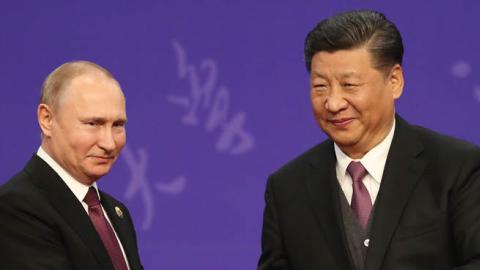__The Look Ahead Series is a collection of policy memos examining the challenges that political, military, and business leaders must contend with today to ensure a secure, free, and prosperous world tomorrow.__
The Trump administration has described the People’s Republic of China and the Russian Federation as the most significant great-power challengers to the United States and its allies, values, and interests. The 2017 US National Security Strategy identified China and Russia as ideological rivals “determined to make economies less free and less fair, to grow their militaries, and to control information and data to repress their societies and expand their influence.”1 The 2018 US National Defense Strategy described China as “a strategic competitor using predatory economics to intimidate its neighbors” while undertaking “a military modernization program that seeks Indo-Pacific regional hegemony in the near-term and displacement of the United States to achieve global preeminence in the future.”2 The document further criticized Russia for seeking “veto power over the economic, diplomatic, and security decisions of its neighbors.”3
Concerns about China and Russia have earned bipartisan consensus among US national security leaders. Antony Blinken, past Deputy Secretary of State and current lead adviser to Joe Biden, described Beijing and Moscow as a common challenge to the US-backed global order, saying, “In both eastern Ukraine and the South China Sea, we’re witnessing efforts to unilaterally and coercively change the status quo—transgressions that the United States and our allies and partners stand united against.”4 Cooperative or competitive, relations among China, Russia, and the United States will have a major impact not just on one another, but also on the broader international system, so the Sino-Russian relationship will remain a US national security priority for years to come.
Sino-Russians are currently in a better position than they have been at any other time in recent history. Their economic, military, and diplomatic cooperation has expanded more rapidly in recent years than most analysts expected. The PRC has become Russia’s most important economic partner, the two governments have established many binational official exchanges, and both nations engage in robust binational security collaboration. Under Chinese President Xi Jinping, PRC policies and rhetoric have moved much closer to those of the Russian government led by President Vladimir Putin. They see Washington thwarting their claims to regional primacy and assert that US leaders have sought to undermine governments, including their own, under the guise of promoting human rights and democracy. Chinese and Russian leaders, including Presidents Xi and Putin, repeatedly affirm mutual support. For example, during a telephone conversation in July 2020, Xi said his government will “always, firmly support Russia's development path that fits its own national conditions.” Xi stressed that “the international situation is changing rapidly” and said, “it is very necessary for China and Russia, as comprehensive strategic partners of coordination, to strengthen strategic communication and cooperation… rejecting external sabotage and intervention, well preserving their respective sovereignty, security and development rights, and well safeguarding their shared interests.” In turn, Putin said, “Russia regards its relations with China as the top foreign policy priority.” He also affirmed that the country “firmly supports China's efforts to safeguard national security in the Hong Kong Special Administrative Region [and] opposes all kinds of provocative actions that violate China's sovereignty.”5
Assessing the Threat
While numerous factors account for the current strong China-Russia alignment, including converging economic incentives and mutual security concerns, one distinct driver is a shared opposition to US policies. Beijing and Moscow seek a world of multiple independent powers with constrained US influence. Both countries aim to develop new international institutions whose norms and procedures differ from the existing ones established by Western governments. They are also striving to subvert the pillars of the liberal democratic world order constructed by the United States after World War II. In Europe, Russia has been annexing new territories and supporting armed proxies in neighboring countries. In the Indo-Pacific region, China has been erecting military facilities in disputed territories and augmenting its power projection capabilities. In their home countries, both insist on strong state sovereignty and the exclusion of foreign interference in their internal affairs. Although they appeal to international law to defend traditional interpretations of state sovereignty, they share an opposition to the Western assertions that universal liberal values transcend national boundaries. This reflects a common desire to shield their human rights abuses and those of their client regimes.
The extent of Sino-Russian cooperation varies substantially by time, region, and topic, but the two countries work most closely on defense issues, including arms sales and exercises; international institutions, like the United Nations; global messaging or propaganda; arms control; energy market issues; and subjects that concern the regions of Central and Northeast Asia. Their cooperation in the Arctic and outer space is growing, but their coordination in Africa, Europe, the Middle East, and the Western Hemisphere; their humanitarian ties; and their collaboration in economic fields beyond energy remain weak. China and Russia have managed to agree to disagree on issues where they differ—and their compartmentalization helps the pair maintain cooperation in other areas.
Some Sino-Russian collaboration has minimal impact on US interests. There are even opportunities for trilateral collaboration on some areas of common interest, such as mitigating the impact of global climate change and promoting world health. Other Chinese-Russian collaboration threatens substantial harm to the United States and its allies. For example, the weaponry Russia has supplied China gives the People’s Liberation Army more coercive options in Asia against the United States and its allies. This Sino-Russian defense cooperation will unfortunately continue for years due to their many institutional connections, mutual benefits from such collaboration, and lack of alternative security partners. Throughout the Syrian conflict, Chinese and Russian envoys have collaborated to block resolutions that would have condemned the authoritarian regimes in Syria and Belarus. In Asia, the PRC offers Russia ready capital and a ready customer in the energy domain. Geographic proximity between Russia’s vast reserves of oil and gas and China’s huge market creates a natural synergy. The two governments are aligning their Eurasian integration initiatives—Beijing’s Belt and Road Initiative and Moscow’s Eurasian Economic Union—to the detriment of US regional commercial interests.
Optimizing the US Response
Changing specific policies toward China or Russia in an effort to meet their objections is unlikely to pull them away from each other. Their opposition to the United States is comprehensive, not sectoral or tactical. It is also hard to see how their relations will soon degrade to any level near their Cold War-era animosity, allowing the United States to move between them. As their security and economic ties have grown, the likelihood that either will discard the other in a fit of self-interest has decreased—but the United States and other democracies are not powerless in the face of these challenges. One reason Beijing and Moscow are aligning more is that they have antagonized most of their other important neighbors. Democracies in Europe and Asia have been rallying behind US leadership in resisting Chinese and Russian economic predations and military threats. The United States benefits immensely from its portfolio of alliances and partnerships.6 While the US can project power unlike any other nation in history, this is only possible because of its allied network.
Regarding arms sales, the United States should complement its sanctions designed to discourage its friends and allies from selling defense and dual-use technologies to China and Russia, which have proved unsuccessful in some cases, with more positive engagement efforts. Conversely, regarding non-military sanctions, US policy makers should explicitly weigh the balance between the value of these measures in weakening the Chinese and Russian economies with the impetus they provide for driving Beijing and Moscow together. Furthermore, the United States should maintain multinational research and development interoperability efforts in important emerging defense and dual-use technologies, such as stealth, nanotechnology, and artificial intelligence, as well as expand allied collaboration in the cyber and space domains.
Enhanced public-private partnerships between Western governments and private-sector social media companies will help counter the increasingly sophisticated disinformation offensives of China and Russia. Since Chinese trade and investment has not assisted Russia in diversifying its economy away from predominately exporting natural resources, US influence operations should stoke Russian suspicions that China wants to keep Russia in an unbalanced commercial relationship. Furthermore, the United States should augment its efforts to provide alternative financing for countries that are understandably reluctant to accept PRC investment.
US planners must prepare for military contingencies involving both China and Russia. Even if the two countries do not combine their forces in a joint operation, one could exploit a conflict between the other country and the United States to opportunistically advance its own security interests. The United States will need capabilities to deal with simultaneous threats from Beijing and Moscow—maintaining sufficient resources to withstand military pressures from one party while the Pentagon responds to aggression by the other.
The next administration should continue to insist that China join Russia and the United States in accepting legally binding limits on strategic forces—both because an unconstrained PRC nuclear weapons buildup will destabilize international security and because this approach could provide a wedge between Russian leaders, who privately favor such limits, and PRC leadership, which prefers Russian and US military defenses be constrained while China’s are not. In the space domain, the United States has considerably decreased its dependence on Russian technologies, companies, and supplies; the next administration should strive to make comparable progress concerning China.
Finally, the magnitude and multifarious nature of the Sino-Russian challenge underscores the need for more robust intelligence capabilities within the US government and analytical efforts within the think-tank community to assess the nature, extent, trajectory, and vulnerabilities of the Chinese-Russian partnership.



















